Table 2.
Twenty-Four Themes That Promote Adoption and Sustained Use of Liquefied Petroleum Gas Stoves.
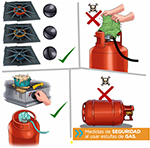
|
Theme 1. If the necessary safety measures are followed, the cylinder and gas stove are very safe Message: Although people fear gas explosions, gas use is safe. Explosions or accidents are caused by poor cooking practices and poorly maintained cylinders or hoses. To avoid this, we must follow safe procedures, which are easy to learn and remember: look for a blue flame; if water falls on the gas flame and it goes off, turn off the stove knob; do not put a wet rag on the cylinder, this does not prevent gas leaks; do the soap test if you suspect a leak; do not store the cylinder on its side and call the technical team if you do not know what to do or how to handle the cylinder. We must always remember to ventilate the area (open doors and windows) before turning on the stove, in case we suspect a leak. Drawing: Drawings (flame size, wet rag, pot boiling over, soap test, cylinder on side) with checks and X’s |
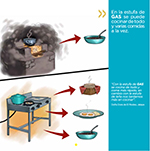
|
Theme 2: Everything can be cooked on the gas stove and many foods can be cooked all at once Message: There is a perception that certain foods have flavor when they are cooked with clay pots. But in reality, cooking processes can be changed such as using more or less oil or more or less water. We can soak beans before cooking them. This will reduce the cooking time and the amount of fuel. The use of condiments such as onions, garlic, pepper, and salt, gives food a pleasant taste. The palate can “readjust” its memory. Drawing: First drawing—smoky kitchen, one pot of beans cooking on high flame. Second drawing—Pots of different sizes with diversity of food (beans; tortillas; eggs) on the three burners. |
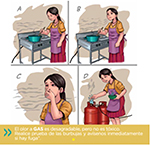
|
Theme 3: The smell of gas can be unpleasant, but it is not toxic. Use the soap test and call us immediately if there is a leak Message: Many people associate the smell of gas with something toxic. This odor is a substance called mercaptan. The companies that manufacture gas add it as a safety measure to quickly notice when there is a leak, or when one of the burners is left on. This substance is nontoxic, it only has an unpleasant odor. Drawing: Drawing of a woman smelling gas, recognizing a leak and performing the soap check to detect a leak. |
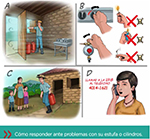
|
Theme 4. How to respond to problems with the gas stove and cylinders Message: HAPIN (Household Air Pollution Intervention Network) staff technicians will install the gas stove and two gas cylinders in the home. Household members will be taught by the technicians to switch the gas flow between the two cylinders, how to use the stove, including how to turn the gas flame on and off, how to use the spark lighter that will be provided, and how to cook with gas. We will also give instructions on how to detect and respond to leaks from the cylinder or stove. In case of a malfunction, the family will communicate with the technical support staff who will come to review the stove and cylinders. Drawing: Show a man responding to a situation of risk (gas leak) 1. In case of suspected leak, switch off the stove and close the valve 2. When the cylinder is inside the kitchen or a room, open all windows and doors to ventilate the room 3. DO NOT light matches, cigarettes or any other item to make fire 4. In case the cylinder is inside the kitchen, disconnect the cylinder and take it outside Call us on the phone |
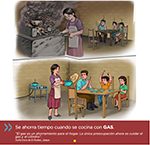
|
Theme 5. I save time when I cook with gas instead of wood Message: The delivery of the stove will be accompanied by two 25-pound gas cylinders. When the first cylinder runs out, the family should switch the valve to start using the second cylinder and call the study team using the toll-free number provided to them. The study team will deliver a replacement of the empty cylinder within 2 days. Drawing: First family: A woman cooking with firewood (with a hungry family waiting to eat). Second family: woman serving hot food (with the family ready to eat) |
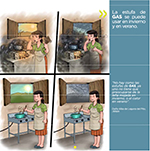
|
Theme 6. I can use the gas stove during the summer and the winter Message: Avoiding the use of firewood will prevent the kitchen area from getting too hot during the summer months. During the rainy winter months, using the gas stove avoids using wet firewood that produces a lot of smoke. Drawing: First set of pictures: A very hot woman sweating while cooking in the summer months. The same woman with discomfort caused by the smoke generated by wet wood used during the rainy season. Second set of pictures: Show the same woman cooking without problems and discomfort during the dry and rainy season. The room is cool and there is no smoke. |
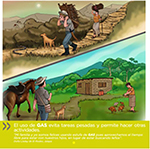
|
Theme 7: The use of gas helps me avoid cumbersome tasks and allows me time for other activities Message: Collecting firewood involves activities such as going out frequently to search, cut, collect and transport firewood, travelling long and dangerous distances carrying heavy loads of wood. During the summer, this is made difficult due to excessive heat and during the winter, by heavy rains. Snake bites are common and dangerous. With gas, we no longer occur have to gather wood. Drawing: First drawing: A man and a woman carrying wood on their backs and heads as they walk steep trails with a snake traversing the path. Second drawing: A man walking back from his plot to his house without a wood load. House has two gas cylinders outside and a woman feeding chickens. |
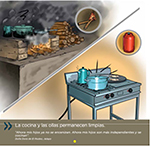
|
Theme 8: The kitchen and pots and pans stay clean Message: When using wood for cooking, the pots blacken and are very difficult to clean. This means that it is hard to keep the kitchen looking clean and the pots deteriorate over time. Using gas stoves avoids this, even if clay pots are used. The pots stay cleaner and last longer. Drawing: First picture: Stained pots damaged by ashes. Second picture: Clean, well-maintained pots on a gas stove. |
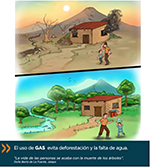
|
Theme 9: The use of gas prevents deforestation and lack of water Message: By consuming firewood every day we are contributing to deforestation. With the passage of time, it will be more difficult to find firewood, causing more droughts and lack of water, aspects that have a direct impact on our well-being, health and economy (corn and coffee crops). Drawing: First picture: A home with smoke coming from the window (indicating wood use) with a dried-up river, hot sun, and deforested mountains. Second picture: Home with gas cylinders, a blue river, green trees, father and son playing on grass. |
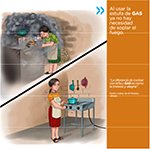
|
Theme 10: There is no need to blow on the fire when using the gas stove Message: The use of gas prevents women or children from blowing on the fire to stoke embers. This is not only an annoyance and can be arduous (especially when the wood is wet or freshly cut), but also prevents breathing in smoke and prevents ashes from falling into the food, clothing, and the kitchen. Drawing: First picture: A woman struggling to light the fire, which is constantly extinguished, causing more smoke and discomfort, as well as delaying the cooking process. Second picture: A woman easily igniting the gas stove. |

|
Theme 11: You can use the gas stove to make tortillas Message: The stove has three burners, one of which is large and contains a flat metal comal, or plancha, to make tortillas. However, if you prefer to use clay comales, you can dismantle the metal comal and place a clay comal about 16 inches in circumference. Drawing: First picture: clay comal on a cracked raised open fire (polletón) with photos of chicken dish and plates, accentuating the crack of this stove. Second picture: built-in comal on the gas stove. |
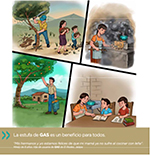
|
Theme 12: The gas stove benefits everyone Message: The prolonged use of the gas stove has various impacts on personal, family and community life. Some of these can be direct and personal, such as more time for other activities and less discomfort when cooking; others indirect, such as a cleaner home; but can affect the community, since we conserve natural resources of the area and keep the air cleaner when we don’t burn wood. Drawing: First set of pictures: Each member of the family involved in an activity dedicated to the use of firewood (extraction, cutting, loading, cooking). Second set of pictures: A mother helping with homework for the children and a man picking fruit from a tree. |
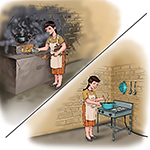
|
Theme 13. Burning trash and using green wood in the cooking fire is toxic for health. Using a gas stove helps us avoid trash fires and using green wood in the kitchen. Message: When using gas, we avoid burning garbage like plastic (e.g., bottles of soda, chip bags, etc.) in the cooking fire. Green wood, or uncured wood, is very smoky. This smoke is highly toxic to our health and also contributes to environmental, or outdoor, pollution. Drawing: First picture: A woman putting garbage on the fire, and “green” firewood (freshly cut or wet), which causes a lot of smoke and discomfort. Second picture: A woman cooking with gas without discomfort |
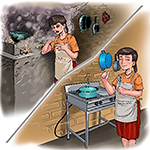
|
Theme 14: Wood smoke is harmful even though it comes from trees Message: Although wood is of plant origin, when burned it produces toxic substances similar to those produced by cigarettes, and this smoke affects our respiratory system. These inhaled substances cause many respiratory problems. The most vulnerable groups are young children, women and the elderly. Drawing: First picture: A woman inhaling wood smoke and coughing. Second picture: Same woman, without symptoms, using a gas stove. |
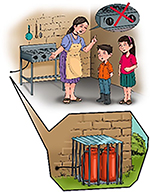
|
Theme 15: Precautionary measures keep our children safe Message: Just as we protect young children from approaching the wood fire, children should also be taught that a gas stove and cylinder are not toys and should not be touched. To avoid incidents of this type it is recommended (1) to educate the children to stay away from the stove, (2) to place the cylinder outside if possible (not exposed to rain and sun), (3) to place the cylinder inside a padlocked area if possible. The latter also prevents cylinder theft. Drawing: Mom educating the children not to manipulate the stove knobs. Gas cylinders located on the other side of the wall in a padlocked cage with protective aluminum roof. |
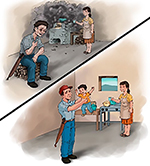
|
Theme 16. The smoke produced by firewood affects everyone Message: Although there is a perception that smoke sickens some, while only causing discomfort to others, all inhabitants of households that use firewood suffer consequences caused by smoke. Smoke is harmful even if we don’t see it, since the particles produced during combustion spread throughout the house. It does not matter if someone is considered strong or resistant to smoke. Everyone is vulnerable to the negative effects of smoke. Drawing: First picture: A family that uses wood for cooking, where the father is sick Second picture: the same man, healthy and playing with children, with a woman cooking with gas |
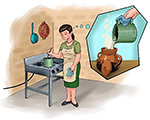
|
Theme 17. Food can remain hot if we use certain types of pots Message: Clay pots are efficient, allowing rapid heat transmission and long heat conservation. That is why when the fire is extinguished, the food remains hot longer. In this way we could cook with metal pots and then place the contents in clay pots to keep food hot longer, if we want to avoid re-lighting the gas stove. Drawing: A woman making porridge in a metal pot on the gas stove and pouring it into a clay pot |
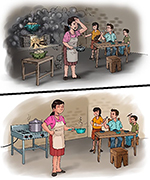
|
Theme 18. Cooking with firewood is NOT part of our culture Message: There is a perception that things are done because it is part of culture—practices or ideas that are transmitted from generation to generation. But often these practices or ideas are habits, conditioned by our socio-economic environment. Cooking with firewood is one example. The use of firewood is predicated by other conditions, such as easy access to firewood and lack of money or opportunities to purchase gas stoves and cylinders. Is the wood stove part of our cultural heritage? If it allows us to strengthen social bonds, promote important values such as unity and solidarity, becomes our cultural identity, then yes. But more often than not, the use of woodstoves is due to lack of economic opportunities. Drawing: First picture: A woman cooking beans and making tortillas or preparing tamales is a wood stove, tired and sweating. Second picture: A woman doing the same on a gas stove. |
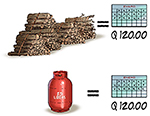
|
Theme 19. The use of gas saves money Message: Some think that the expenditure on fuelwood is lower than the expenditure on gas. One of the factors that perpetuates this idea is that fuelwood is cheaper because it is paid for small rations. But when converting the total fuelwood payment over a month, wood costs are higher than gas payment. Drawing: Shows a lot of wood accumulated in the house with a monetary equivalent versus a single cylinder and its value. |
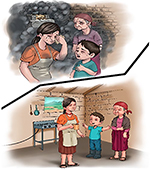
|
Theme 20. The continuous use of the gas stove prevents discomfort/illness/accidents Message: Frequent and prolonged use of firewood and exposure to woodsmoke can cause illnesses or discomfort, and even death. Many times, we associate diseases with other causes, or we do not know their origin. Pneumonia in children and adults, chronic cough, chronic lung disease, lung cancer, cataracts, cardiovascular disease, premature birth and low birth weight may be some of the diseases caused by exposure to smoke. The risk of burns also increases with woodstoves. Drawing: First picture: A sick family, each suffering from a different disease (boy with cough, mother with burning eyes, grandmother with cataracts). Second picture: Same family, healthy, with a gas stove. |
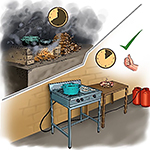
|
Theme 21. Keeping foods hot depends on the material of the pots in which they are stored. You can quickly reheat foods after cooking them on the gas stove. This is different than wood stoves, where you have to continually feed the fire throughout the day to keep the fire and the food hot. Message: The plancha stoves have a large surface to make tortillas, and you can leave several pots on the plancha after they have been cooked, to keep food warm. However, this requires stoking the fire throughout the day to keep the surface warm. In addition, tortillas are made before or after a mealtime is over. The gas stove has enough burners to cover all needs. We can learn to make efficient use of the gas stove, reheating food when we want to eat. The gas stove is “on/off” while the plancha stove needs embers all day to fire up during cooking times. Drawing: First picture: Several pots on the plancha with a clock showing 8 hours (time the fire has remained on) next to a tower of logs. Second picture: Several pots and a comal on the gas stove, with a cylinder that indicates a minimum use of gas, and the same clock showing the lapse of two hours. |
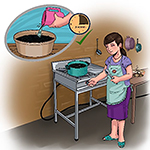
|
Theme 22. I will never be without the possibility of cooking Message: The stove will be accompanied by two 25-pound gas cylinders. When the first cylinder runs out, the family should call the study team to the toll-free number so that we can replace the empty cylinder. Many people use the gas stove only to cook foods that are quick to cook (such as eggs, precooked rice, coffee) or to reheat food. However, the functionality of the gas stove is the same as that of a plancha or open fire. You must learn to regulate the flame of the stove and look for the most suitable pots so that the combustion of the gas is more efficient. Drawing: Woman cooking beans on the gas stove. An inserted drawing where the beans are soaking, then being placed on the stove at low flame. |
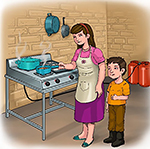
|
Theme 23. On the gas stove you can cook everything, we only need to learn how to adjust the flame, which is easier to control than putting logs of various sizes and thickness Message: The stove allows us to make use of different types and sizes of pots, even clay pots. It is important to regulate the flame of the gas stove. The flame is not only “very weak” or “very strong,” there are, between these two levels, other gradient levels of flame. Drawing: A woman cooking with pots of different sizes on the three burners. |
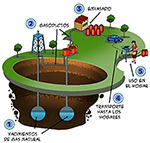
|
Theme 24. Where does gas come from? Message: Gas is a natural fuel (i.e., it has not been created by man), composed of a mixture of hydrocarbons (substances formed by carbon and hydrogen), of fossil origin (petrified remains of something previously living, like plants, which died billions of years ago) that are found underground. Gas is a nontoxic, colorless, odorless, and lighter product than air. Once extracted from the subsoil gas it is transported through gas pipelines. Drawing: A drawing illustrating the process of gas extraction and bottling. This gas cylinder is then shown placed near the stove of the study woman. |
Note. First 12 themes formed the calendar messages.
